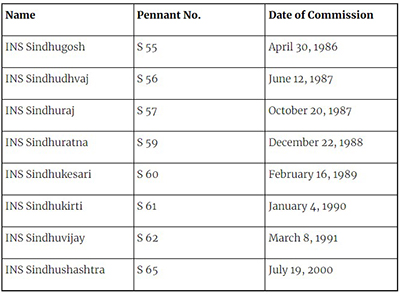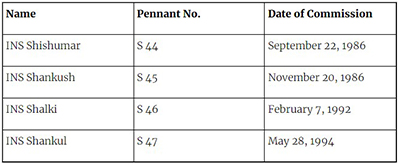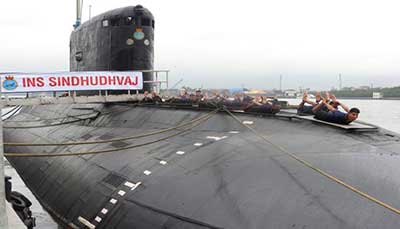Relevance: GS-3: Indigenisation of technology and developing new technology.
Key Phrases: Kilo-class submarine, INS Sindhudhvaj, Nuclear deterrence, INS Kalvari, Arihant class, Nuclear-powered Ballistic Missile, Sindhughosh Class, Shishumar Class, Maritime security, Countering China.
Why in News?
- Recently INS Sindhudhvaj, Kilo-class submarine of Indian Navy was decommissioned from service at Visakhapatnam after 35 years in service.
- With this, the Navy now has 15 conventional submarines in service.
What is a submarine?
- A submarine (or sub) is a watercraft capable of independent operation underwater. Submarines are referred to as “boats” rather than “ships” irrespective of their size.
- Although experimental submarines were built earlier, the concept gained traction during the 19th century, and they were used by several Navies.
- The first major usage of submarines was seen during World War I and is now used in many Navies, large and small.
- Military uses of submarines includes:
- attacking enemy surface ships and for aircraft carrier protection,
- blockade running,
- nuclear deterrence,
- reconnaissance,
- conventional land attack (for example, using a cruise missile),
- covert insertion of special forces.
INS Sindhudhvaj:
- It was one of the ten Kilo class submarines India obtained from Russia between 1986 and 2000.
- It was commissioned into the Navy in 1987.
- INS Sindhudhvaj has many firsts to her credit which includes
- operationalisation of the indigenised sonar USHUS,
- indigenised satellite communication system Rukmani and MSS,
- inertial navigation system and
- indigenised torpedo fire control system.
- It was the only submarine to be awarded the Chief of Naval Staff rolling trophy for Innovation.
Kilo-class submarine:
- Kilo-class submarine are diesel-electric submarines that
- displace 3,000 tonnes,
- can dive to a depth of 300 metres,
- have a top speed of 18 knots, and
- can operate solo for 45 days with a crew of 53.
- The Kilo-class submarine are called the Sindhughosh-class, after the lead vessel in the series.
- The Kilo-class is a highly trusted conventional boat, with an estimated 62 in service in nine Navies.
- They were the Indian Navy’s first submarines that could fire anti-ship and land-attack cruise missiles from underwater.
Do you Know?
- INS Sindhurakshak was lost in an accident in Mumbai harbour in August 2013.
- INS Sindhuvir was transferred to Myanmar in 2020, making it the South East Asian nation’s first underwater platform. It has been inducted into the Myanmar navy under the name UMS Minye Theinkhathu.
- Currently, India has
- 15 conventional diesel-electric submarines, classified as SSKs(Diesel-electric attack submarine)
- One nuclear ballistic submarine, classified as SSBN(Nuclear-powered ballistic missile submarines).
- Of the SSKs,
- Four are Shishumar Class, which were bought and then built in India in collaboration with the Germans starting 1980s.
- Eight are Kilo Class or Sindhughosh Class bought from Russia (including erstwhile USSR) between 1984 and 2000.
- Three are Kalvari Class Scorpene submarines built at India’s Mazagon Dock in partnership with France’s Naval Group, earlier called DCNS.
Why India needs submarines?
- India needs more submarines mainly for following reasons:
- For our own maritime security:
- For maintenance of the territorial integrity of India
- Against all types of seaward challenges and threats as well as protection of our maritime trade and the merchantmen.
- To safeguard the maritime interests of the nation.
- To meet the new challenges continuously evolving. Since the security challenges are only bound to increase in the times to come.
- Countering China:
- Chinese are going to be positioning a lot more ships and submarines in the Indian Ocean in the coming years.
- China is giving Pakistan eight submarines and four destroyers, which can be used as proxy by China.
- According to a 2020 report by the Pentagon, China currently operates four SSBNs and is fitting two additional hulls. It has six SSNs and, and 50 diesel-powered attack submarines (SSs).
- For our own maritime security:
Way Forward
- The naval prowess of India must be accorded primacy to mitigate the gap that exists with rival counties like China else India will be handicapped in countering China’s desire to dominate the Indian Ocean.
- India needs to change its decision-making processes and its complicated acquisitions process to halt the slide in its relative capabilities.
Source: The Hindu
Additional Material
Submarines in India Navy:
- India's tryst with submarines began in December 1967 with the INS Kalvari of the Foxtrot Class from the USSR. By 1969, India had four of those.
- During the 1971 India-Pakistan war, the submarines were used in war.
- Between 1971-74, India bought four more Foxtrot Class submarines but then for a decade, we did not get any new submarines.
- In 1981, it signed a contract to buy two Type 209 submarines from West Germany, while two others were to be assembled at Mazgaon Dock, which formed the Shishumar Class.
- India got eight submarines from the USSR and the two from Germany from 1986 to 1992.
- In 1992 and 1994, two German submarines which had been built in India were also commissioned. India bought two Kilo Class submarines from Russia in 1999 and 2000.
- The 30-year plan (2000-30) for indigenous submarine construction, approved by the Cabinet Committee on Security in 1999, envisaged two production lines of six submarines each, built in India in partnership with a foreign Original Equipment Manufacturer (OEM). The projects were called P-75 and P-75I.
- The 30-year plan anticipated that India would get the 12 new submarines by 2012-15. Subsequently, India would make 12 of its own by 2030, taking the fleet size to 24, with the older submarines getting decommissioned.
Types of submarines:
Submarines can either be diesel-electric or nuclear-powered. Either type can hold nuclear warheads.
- Diesel-electric submarines:
- It use electric motors charged by diesel engines to move.
- These engines require air and fuel to operate, which means they need to resurface more frequently, making them easier to detect.
- When running on electric mode, these submarines are much quieter than when the diesel engines are running.
- Most submarines today are conventionally powered (diesel-electric) and tend to be smaller and cheaper to maintain.
- Nuclear-powered submarines:
- Nuclear-powered submarines run off of steam generated by an onboard nuclear reactor that turns the turbines.
- Having a source of power that runs for so long means that they can remain submerged for years – effectively limited only by the food and water needs of their crews – limiting their detection.
- These tend to be larger but require more expensive infrastructure and maintenance.
- Common submarine acronyms are listed below:
- SS: Submarine (submersible ship)
- SSK: Diesel-electric attack submarine
- SSN: Nuclear-powered attack submarine
- SSB: Diesel-electric ballistic missile submarines
- SSBN: Nuclear-powered ballistic missile submarines
Submarines in the Indian Navy:
- Arihant class
- The Arihant is a class of Indian nuclear-powered ballistic missile submarines being built for the Indian Navy.
- They were developed under the Rs 900 billion Advanced Technology Vessel (ATV) project to design and build nuclear-powered submarines.
- India has classified these vessels as 'strategic strike nuclear submarines'.
- Launched on July 26, 2009, INS Arihant (SSBN 80), designated S2 Strategic Strike Nuclear Submarine, is the lead ship of India's Arihant class of submarines.
- The 6,000-tonne vessel was built under the ATV project at Visakhapatnam's Ship Building Centre.
- The submarine was commissioned in August 2016 and was deployed for operations in 2018.

- Kalvari Class
- Under Project 75 project, the Indian Navy intends to acquire 6 diesel electric submarines, which will also feature advanced Air Independent Propulsion (AIP).
- The first submarine in the series, INS Kalvari, was launched in October 2015 and was commissioned in December 2017 - five years behind schedule.
- The second one, INS Khanderi, was launched in January 2017 for trials and commissioned in September 2019.
- The third submarine, INS Karanj, was launched in January 2018 and commissioned on March 10, 2021.
- INS Vela is the fourth one.
- The fifth one, INS Vagir, was launched in November 2020 and has commenced harbour trials. It is expected to go for its maiden surface sortie in December 2021.
- The sixth submarine, INS Vagsheer, is in the advanced stage of outfitting.
Do you know about Air-independent propulsion?
- It is any technology which allows a non-nuclear submarine to operate without the need to access atmospheric oxygen (by surfacing or using a snorkel).
- It also reduces the chances of detection because the moment it comes closer to the surface, submarines are very prone to detection and after that, it becomes very difficult for a submarine to hide because it cannot move quickly under the water.
- AIP gives longer endurance to submarines than what a conventional battery submarine can offer.
- Sindhughosh Class
- Sindhughosh class submarines are Kilo-class diesel-electric submarines and are designated 877EKM.
- The ships are the products of a contract between Rosvooruzhenie and the Union Ministry of Defence.

- Shishumar Class
- The Shishumar class vessels (Type 1500) are diesel-electric submarines which have been developed by the German yard Howaldtswerke-Deutsche Werft (HDW).
- The first two of these vessels were built by HDW at Kiel, while the remainder has been built at Mazagon Dock Limited (MDL) in Mumbai.
- The ships were commissioned between 1986 and 1994.

Mains Question:
Q. In order to safeguard the maritime interests of the nation, submarines are very crucial. Examine the statement in the light Naval preparedness of India.







